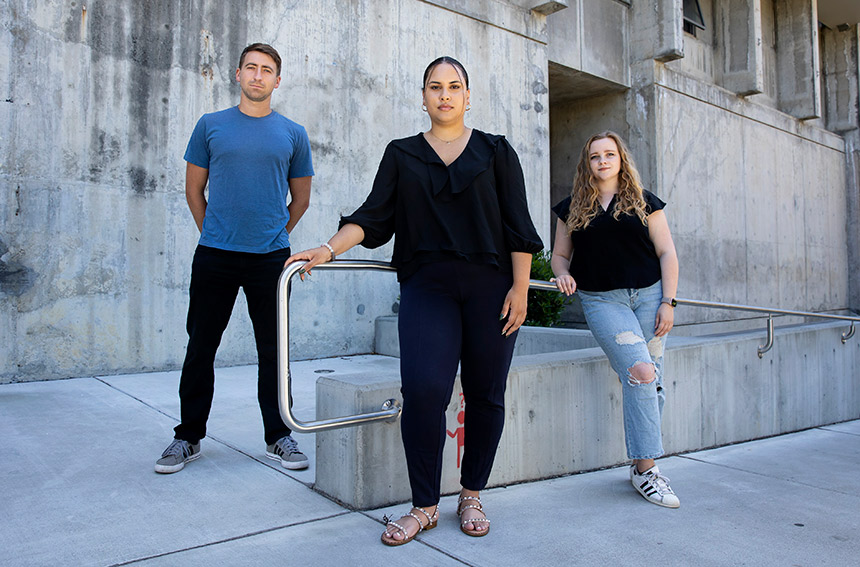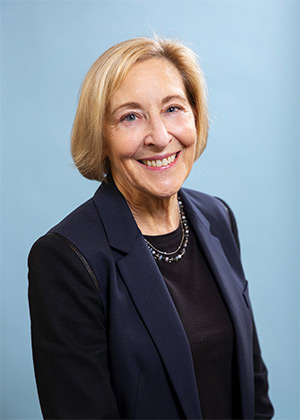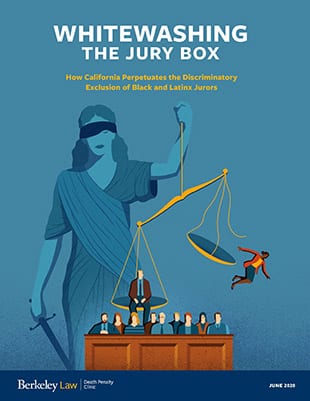
By Sarah Weld
Key research by Berkeley Law’s Death Penalty Clinic is helping courts and state legislatures tackle racial discrimination in jury selection across the country.
The clinic’s 2020 Whitewashing the Jury Box report, which found racial discrimination by prosecutors in jury selection in California, led directly to a new law that same year dramatically altering how criminal trial juries are selected in the state.
This year, attorneys representing a Kansas client facing the death penalty asked Clinic Co-Director Elisabeth Semel to help prove that such punishment violates the state constitution. They asked the clinic to analyze more than 200 Kansas jury selection cases to see if courts had addressed racial discrimination by prosecutors.

“We turned to Professor Semel and the Death Penalty Clinic because of the clinic’s outstanding report about jury selection in California. The report detailed how and why existing law failed to prevent discrimination in jury selection,” says Cassy Stubbs, director of the ACLU Capital Punishment Project. “Professor Semel and the students compiled their results in a comprehensive and devastating report detailing the systemic discrimination against jurors of color in Kansas.”
The clinic’s new report is part of a challenge to the Kansas death penalty statute brought by the ACLU, the ACLU of Kansas, and the law firm Hogan Lovells in Kansas v. Cornell McNeal.
The clinic’s Kansas research very much mirrored the results of its California report, including why and how often prosecutors removed Black prospective jurors. In its 2020 study, the clinic looked closely at California’s long history of excluding people of color — particularly African Americans — from criminal trial juries through prosecutors’ peremptory challenges. By statute, lawyers on both sides are allowed a set number of peremptory challenges, which they may use to excuse potential jurors without stating a reason.
In 1986, the U.S. Supreme Court decided in Batson v. Kentucky that the Constitution prohibits a peremptory challenge when it is based on race. The Court imposed a limit on the use of peremptory challenges, which it extended to strikes based on ethnicity and gender, and states have extended to other categories such as national origin and sexual orientation.
Yet Batson requires anyone objecting to a peremptory challenge to prove the strike was intentionally discriminatory, leaving no room for a court to consider implicit bias. The clinic’s research shows how Batson has done little to prevent prosecutors from removing the majority of prospective Black and Latino jurors.
“We were looking at the big picture in Kansas since 1986 when Batson was decided. How has Batson functioned there? Has it proved to be an effective method for protecting equal rights, or has it been a failure? Our answer is: It’s no more effective in Kansas than in any other state,” says Semel, who also wrote comments for a New Jersey Supreme Court conference on the issue last year.
Semel and students Max Endicott ’22 and Maddy Pilgrim ’22 reviewed 208 opinions involving Batson challenges decided by the Kansas Supreme Court or Court of Appeals between 1987 and 2021, and Alexis Hoffman ’22, Devin Oliver ’22, and Aysha Spencer ’22 helped prepare and finalize the report. They found that, similar to the clinic’s California findings, Kansas prosecutors have disproportionately exercised peremptory strikes against Black jurors, and despite Batson’s objective, relied upon racial stereotypes to justify their strikes.
Prosecutors removed at least half of the jurors of color in more than half of the cases, and removed all of them in at least one-third of the cases. Their challenges were often based on racial stereotypes such as the jurors’ demeanor or appearance, a negative experience with law enforcement, the nature of their employment, or where they live.
“The courts find over and over again that prosecutors have not engaged in intentional discrimination,” Semel says. “Often their strikes are the product of implicit and unconscious racism. Batson does not prohibit that kind of conduct.”
Sparking a movement
The clinic’s work on this issue in Kansas and California reflects a growing trend since 2018, when the Washington Supreme Court became the nation’s first to adopt a rule aimed at eliminating implicit racial bias in jury selection.
And since California’s Assembly Bill 3070 passed in 2020, the clinic has been tracking efforts by other states to confront racial discrimination in jury selection by reforming Batson. So far, just under 10 states have released their own reports and recommendations. Still others are exploring significant changes through the legislature and courts, many of them using California’s law or the Washington rule as a starting point.
While Semel emphasizes that the clinic will always remain committed to representing clients facing the death penalty, she welcomes the chance to advance sweeping policy change.
“My ambition is for every state and the federal judicial system to abandon Batson and replace it with a procedure that looks similar to Washington’s General Rule 37 or California’s AB 3070,” Semel says. “This is admittedly a big lift and will require participation from stakeholders in every jurisdiction. As a litigator, I have worked on this issue for many years, losing more than winning. It is exciting to be engaged in an effort that promises structural change.”
The students agree.
“It felt so impactful to be a part of something that would be tangible, lasting, and could be looked to in the future for policy changes,” says Pilgrim, who along with Endicott, had primary responsibility for analyzing the data. “I thought we were setting out to set Kansas apart, but really we were documenting that Kansas was just like every state across the U.S. Batson fails everyone, everywhere, because it was never meant to actually protect anyone.”
Major satisfaction
The students who worked intensely reviewing hundreds of cases over a short three-month period impressed the group of veteran attorneys handling the Kansas case.
“The amount of work Lis and her students conducted on a very tight timeline was truly staggering. They were absolutely phenomenal,” says Katie Ali, a partner at Hogan Lovells. “They worked tirelessly — literally around the clock at times — to put together a thorough and compelling report that left no doubt that jury selection in Kansas capital cases suffers from systemic racial bias.”

The students describe working on the report as one of the highlights of their law school years, illustrating how clinical education complements the traditional classroom model.
“The Death Penalty Clinic was the most intense experience I had in law school. It forced me to elevate my game. Once a week I would meet with Lis and have my memos dissected by an expert legal mind. I have never had that kind of attention before,” says Max Endicott ’22, who will work as a public defender at the Bronx Defenders this fall.
“That kind of one-on-one review of your work and ability to discuss legal ideas, and have your writing style and skills challenged, is a unique experience. The doctrinal classes help give you the foundation and the experiential opportunities really hammer it home and make it practical.”
Spencer agrees that the individual attention she received from Semel was invaluable.
“To have such a devoted, brilliant advocate hone your writing word by word, punctuation by punctuation, line by line is an honor few have,” says Spencer, who will work at Kirkland and Ellis in Texas. “I got to not only see on a daily basis how such an extraordinary legal mind works, but also tussle with her in the best way on how we should advocate for our clients, and our disagreements made not only us better but our work product even better. I cried every day for a month leading up to graduating from Berkeley Law and the reality that I would have to leave the clinic was a big part of that.”
Through participating in a clinic, students can try real-world lawyering, immersing themselves in hands-on legal work and acquiring skills that prepare them for a wide range of legal careers.
“Aside from the invaluable research and writing skills, mentorship, and experience in the capital litigation process, I learned how to keep hope going and keep acting on it. The clinic has set the tone for my future career as a public defender, giving me the skills necessary to keep up the fight for my clients,” says Pilgrim, who will be a graduate law clerk at Contra Costa Public Defenders.
Next steps
Since the clinic filed its report in the Kansas case, there has been good news for the client, Cornell McNeal.
“Shortly after we filed the expert reports and briefs in this case, the State announced it is no longer seeking the death penalty against Mr. McNeal, a tremendous victory for our client. Mr. McNeal will not be subject to a death-qualified jury and the additional layers of discrimination that accompany capital prosecutions,” Stubbs says. “We are confident that Kansas litigators will continue to use the clinic’s report as they push for reform in capital cases and jury selection.”
As for the clinic’s next steps, Semel says she plans to continue working with groups nationwide working to reform Batson through state legislatures and the courts.
“For decades, almost every Batson study criticized its failure to meaningfully reduce prosecutors’ race-based peremptory challenges, but no one had investigated Batson’s application in California. Our study confirmed that California courts have been equally ineffectual and that Batson’s approach must be replaced,” Semel says. “The fact that Washington made something happen and that California did so as well is beginning to seed the belief in judges, lawyers, and legislatures that transformative change is not only necessary, but feasible.”